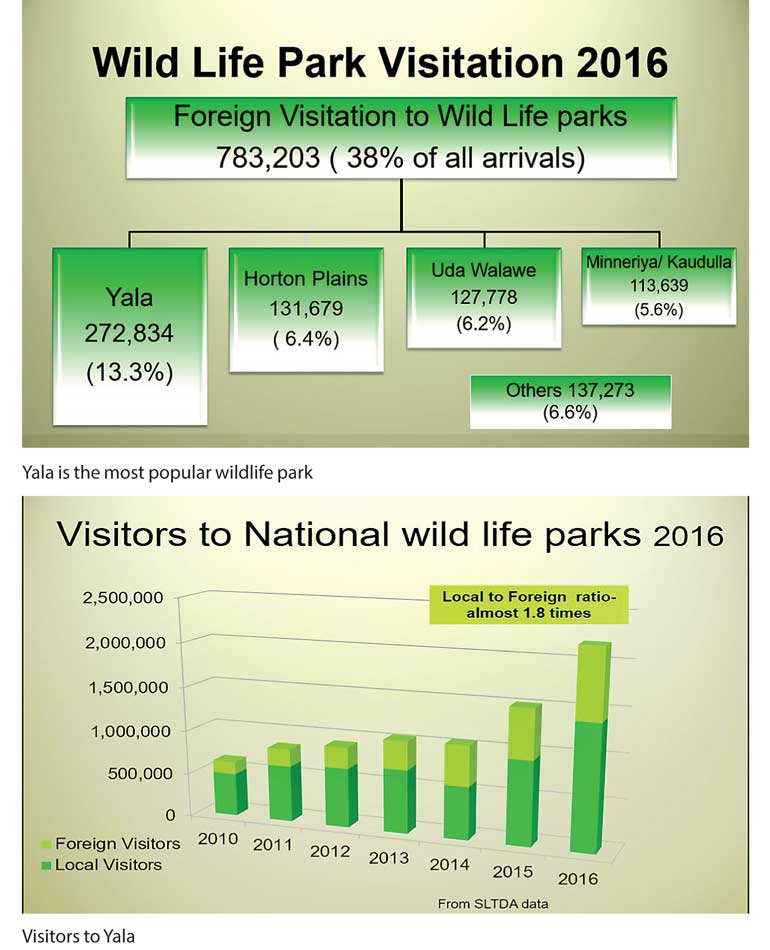Saturday Apr 26, 2025
Saturday Apr 26, 2025
Wednesday, 6 December 2017 00:02 - - {{hitsCtrl.values.hits}}


 Much has been said and debated about the Yala National Park issue, ad nauseam. Many ‘experts’ have cropped up, a dime-a-dozen, giving advice of what needs to be done to solve the problems that prevail. Solutions abound, confusion reigns, with no cohesive action on ground....and life goes on, a la Sri Lankan style.
Much has been said and debated about the Yala National Park issue, ad nauseam. Many ‘experts’ have cropped up, a dime-a-dozen, giving advice of what needs to be done to solve the problems that prevail. Solutions abound, confusion reigns, with no cohesive action on ground....and life goes on, a la Sri Lankan style.
Hence I thought maybe there would be no harm in me also joining the bandwagon, to add my ‘two cents worth’ to the melee. I will aim to highlight some misunderstood aspects of this whole issue, which need clarity and analysis.
There is popular belief that over visitation (i.e. the influx of a large number of jeeps) is the single most issue that is causing ‘damage’ to Yala. However, careful and pragmatic analysis of the problem does reveal another side of the story.
The first main congestion point is when a large number of jeeps enter the park is at the entrance and ticket office. Everyone is aware that the best viewing times for wildlife is early morning and in the evening. So almost all visitors try to enter between 6 a.m. and 7 a.m., and then again around 3 p.m. Therefore it is a common sight to see hundreds of jeeps lined up waiting to enter the park during these times. So the first experience of ‘over-visitation’ is at the ticket counter at the entrance.
However once the jeeps enter the park they fan out to the various loops that emanate from the main road and after that one sees clusters of four to eight jeeps only together. So the impact of ‘overcrowding’ is not at all prevalent during this time.
The next issue crops up when there is a sighting. With mobile coverage available in the park, the message soon goes around and there is a frenzied rush by other jeep drivers in the vicinity to get to the sighting. It is at such instance that the drivers drive at high speeds to get to the sighting before others do.
Hence in a matter of a few minutes there will be some 20-30 jeeps surrounding the animal and vying to get a better view. It ends up as a veritable free-for-all, with park rules all but totally forgotten.
It is common to see jeeps parked off road, shouting at each other, jostling for a better view, tourist standing on top of jeep bonnets and roofs in an effort to get a glimpse of the animal (very often a bear or leopard)
It here that the most ‘overcrowding’ takes place, and all the bad practices happen, all because of some 20-30 jeeps converging on one single sighting without any adherence to park rules.
Around 5:30 p.m. when all jeeps are rushing back to the entrance to beat the 6 p.m. ‘curfew’ a very large number of jeeps are seen together once again.
Hence it is important to differentiate between overcrowding at one particular sighting, as against general over visitation, and not get too focused on the number of jeeps that enter the park.
It would be much more effective, and good for the wild animals and environment, if proper control (sighting protocol) during a sighting is very strictly enforced.
This would include ‘queuing up’ at the sighting without going off road, moving on (after say five minutes of watching) to give others a chance, strictly staying inside the vehicle and keeping quiet etc. In other words there should be a strict ‘sightings protocol’ in place.
An extract from the sightings protocol followed by Simbavati River Lodge in South Africa is given below: ‘A “sighting protocol” means that each game ranger with his vehicle full of guests must log into the sighting, claiming a spot in the queue. There are only two vehicles allowed at a time at the sighting. The ranger that finds the sighting opens the log, and then he passes it on down the queue as the other rangers get into position to enter the sighting. We have a time limit of 15 minutes per sighting if there is a queue. This is the experience that enables us to charge considerable premiums for the exclusivity it gives to the clients at individual sightings rather than on limitation of the jeeps entering the park.”
In fact, having 50 misbehaving visitors (vehicles) inside the park which cause great stress and disruption to animals would be far worse than having 400 vehicles which conform to park regulations and view wild life in a responsible manner. So the main priority should be on proper control at individual sightings rather than on limitation of the jeeps entering the park.
A report was prepared about six months ago by an expert committee (on which the author also served) appointed by the Prime Minster, chaired by Dr. Sumith Pilapitiya, formerly of the World Bank and former Director Wildlife Conservation. Nowhere in this report was immediate limitation of vehicle entry recommended. The whole focus was on establishing proper guidelines for wildlife viewing, enforcing of these rules, and opening up other viewing areas to ease the congestion. It was only after a proper study of carrying capacity that vehicle restrictions were recommenced to be imposed.
It is true that tourism befits a great deal from the Yala National Park, and consequently has a considerable impact on the park itself.
on the park itself.
Of the national parks that tourists visit, Yala is one of Sri Lanka’s best known tourism attractions, and the most visited national park in the country
Based on the author’s research published elsewhere (https://www.academia.edu/35320490/Yala_worth_more_than_Rs.7_B_for_Sri_Lanka), it has been shown that the tourism industry earned more than Rs. 6.3 b as a result of the Yala National Park in 2016.
It is also true that in the desire to please their guests, and get a handsome dollar tip, jeep drivers go to any lengths to show these visitors wildlife at close quarters.
However the larger number of visitors to Yala are the locals (outnumbering tourists by almost 1:8) who cause the greater damage by misbehaving inside the park. It is they who more often flout the rules, harassing animals at close quarters, driving at high speeds in perusing animals, using flash photography, utilising large buses for their safaris, and even alighting from vehicles at times.
If tourists are made aware of the strict rules that prevail, most often they will adhere to this. However they do not have control over what their jeep driver does. Hence it is wrong to place all the current problems of Yala solely on tourism.
Visitor carrying capacities (effectively the number of jeeps allowed inside the park) is dependent on a wide range of factors and it would be extremely complex to analytically work out an estimate.
It is a specialised task which requires intense study and research to gather data about vehicle movements (visitor influx), environmental, flora and terrain aspects, species specific animal behaviour towards visitors, etc.
Carrying capacity cannot therefore be generalised. It is specific to one particular location or exhibit. For example, at the Simbavati privately-owned Game Reserve in South Africa which is open to the Kruger Park, the limit is 16 people per 1,000ha. Yala has approximately 100,000ha and this then does not mean that Yala can sustain 1,600 visitors at a given time!
In addition recent studies have indicated that studying carrying capacity purely based on ecological inputs is not sufficient and that it must be augmented by consideration of ‘human factors’ (or community).
It is understood that the DWC will be initiating a study of the carrying capacity soon, in conjunction with an aid agency.
However there is one clear aspect that stands out – Visitor (vehicle driver) behaviour within the park. It is common knowledge that park regulations and rules are very often flouted, with the DWC being unable to bring to book the miscreants due to political patronage. Hence the behaviour of the jeep drivers predominates this whole issue.
Hence the single most important, and overarching issue is the DWC being able to enforce park regulations strictly, across the board, to all who visit the park, without being influenced by external sources.
Another factor that has to be taken into account in this debate is seasonality.
The average number of vehicles that entered the park each day during 2016 was 364 (ref DWC). However there is a great seasonal variation, and these numbers can go up to over 700 per day during the high season months of August, December, January, and February.
These ‘high season ‘months for tourism arrivals are further compounded during August and December with the local school holiday periods. During these peak times, in the past visitation could go up to 700 or more vehicle per day.
On the other hand during the lean months of May and June it may go down to 150. Hence there appears to be a strong case for a seasonal variation in the vehicle cap that has been introduced per day, if any vehicle entry
The Yala National Park is a valuable national asset. Every effort should be made to protect it and nurture it for future generations. At the same time the park supports a great many people and their livelihoods. It is also one of Sri Lanka’s best known tourist attractions which earns valuable foreign exchange to the country.
All stakeholders are now beginning to realise the actual value of this national asset, and are ready to compromise on their earlier earnings for the greater good of preserving the park in the long-term. So the time is very opportune for the DWC to come up with an equitable compromise solution, and move forward for the greater good of all concerned.
At the same time the Minister of Wildlife should have the commitment to ensure implementation and protect DWC from outside political pressures.
Discover Kapruka, the leading online shopping platform in Sri Lanka, where you can conveniently send Gifts and Flowers to your loved ones for any event including Valentine ’s Day. Explore a wide range of popular Shopping Categories on Kapruka, including Toys, Groceries, Electronics, Birthday Cakes, Fruits, Chocolates, Flower Bouquets, Clothing, Watches, Lingerie, Gift Sets and Jewellery. Also if you’re interested in selling with Kapruka, Partner Central by Kapruka is the best solution to start with. Moreover, through Kapruka Global Shop, you can also enjoy the convenience of purchasing products from renowned platforms like Amazon and eBay and have them delivered to Sri Lanka.
Discover Kapruka, the leading online shopping platform in Sri Lanka, where you can conveniently send Gifts and Flowers to your loved ones for any event including Valentine ’s Day. Explore a wide range of popular Shopping Categories on Kapruka, including Toys, Groceries, Electronics, Birthday Cakes, Fruits, Chocolates, Flower Bouquets, Clothing, Watches, Lingerie, Gift Sets and Jewellery. Also if you’re interested in selling with Kapruka, Partner Central by Kapruka is the best solution to start with. Moreover, through Kapruka Global Shop, you can also enjoy the convenience of purchasing products from renowned platforms like Amazon and eBay and have them delivered to Sri Lanka.